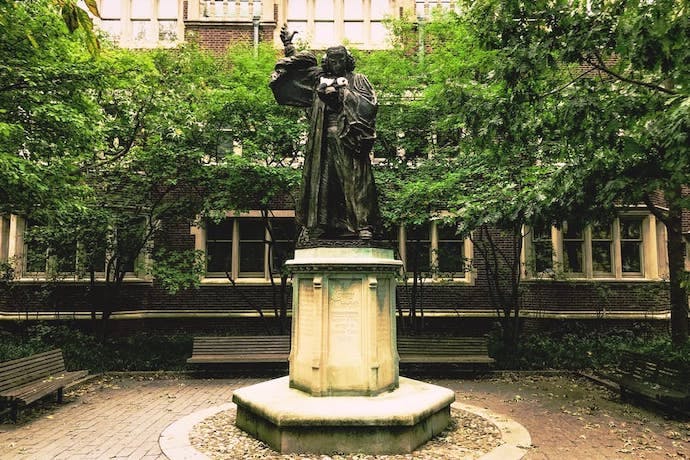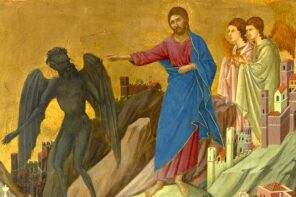It’s a curious fact of history that a statue of John Wesley stands prominently ensconced in the center of downtown Savannah, Georgia. In stark contrast, a nondescript gazebo dedicated to George Whitefield sits nestled in a quiet residential area on the outskirts of town.
It’s not what you’d expect given the history of these two men in Georgia. A young imperious Wesley, fresh out of Oxford, angered British settlers and made a mess of his time in the colony. The failed missionary eventually had to flee Savannah under cover of night with a lawsuit hanging over his head.
Whitefield, on the other hand, was a widely admired, steadfast champion of Georgia. He dedicated over three decades of his life advocating for the fledgling colony’s social and economic success, making time in his busy life as an evangelist, a catalyst for the Great Awakening, and a founder of the evangelical movement in America.
When I was a graduate student doing research in Savannah, the unexpected juxtaposition of Wesley’s statue and Whitefield’s gazebo served as a sobering reminder of the twists of historical memory. It’s a complicated matter to memorialize people and movements.
If Whitefield’s admirers were disappointed with the Savannah gazebo, they did get a statue of their hero at the University of Pennsylvania. After an early model was rejected by donors as “too limp and tepid,” the final version was a rousing success. When one supporter saw it, he exclaimed, “Whitefield is alive! He is resurrected!” Since its unveiling in 1919, the preacher’s towering figure in Philadelphia has become a pilgrimage destination of sorts.
That statue, however, is about to go away. Citing Whitefield’s legacy as an advocate for slavery, university administrators announced on July 2 that they would be taking Whitefield down. For many evangelical Christians, the removal of one of their founding fathers will be a bitter pill to swallow.
Acknowledging the sins of the past is a difficult thing. It’s easier to see history through a rose-colored lens. I’m reminded of Presbyterian pastor Tim Keller, one of the most celebrated preachers for evangelical renewal in our day, who frequently quotes Whitefield in his messages and describes reading all of Whitefield’s sermons as one of the most profound influences on his own preaching. Keller wrote in the New Yorker that true evangelical theology is inconsistent with the racism and xenophobia of politicians like Donald Trump and Roy Moore.
Quibbling with pollsters’ methods for identifying evangelicals and insisting on the purity of evangelical theology, Keller defended true evangelicalism, which he believes stands above racism. If we look back far enough in history, according to this view, a purer version of evangelical faith awaits rediscovery.
But we would search in vain. You can go all the way back to Whitefield and find that it was always possible to preach the Christian gospel and promote white supremacy and chattel slavery at the same time. Whitefield, after all, criticized the belated legalization of slavery in Georgia by lamenting white lives lost: “How many white people have been destroyed for want of [slaves]?”
Historical amnesia is buoyed by the display of statues and the proliferation of hagiographies. It’s also exacerbated by a rhetorical Christianity that denounces the most blatant outward manifestations of racial sin but shirks the hard work of examining the history of evangelical culpability. The truth is, pat answers like “nobody’s perfect” and “we can appreciate the theology of evangelical greats without getting distracted by their cultural and social blind spots” do more harm than good. Enshrining individuals and systems is a sure way to preserve their blind spots too.
For all these reasons, the removal of Whitefield’s statue might actually be good for evangelicals. A moment of apparent defeat may become an opportunity to question their proclivities for hero worship. They may examine myths of evangelical innocence and theological superiority, which obscure the hostile takeover of indigenous lands and violence against enslaved bodies. This more sober understanding of evangelical history might lead to honest reckoning with the deep wounds that continue to fester in our common life together.
A cult of celebrity that papers over a multitude of sins has long been a temptation for evangelicals, long before Trump. The fact is, Whitefield wasn’t just the benevolent founder of an orphanage in Georgia, but a plantation owner who profited from enslaving Africans. Worse, the preacher was an evangelist for British imperial expansion and arguably the most vocal and persistent lobbyist for the legalization of slavery in Georgia.
“I challenge the whole world to produce a single instance of a negro’s being made a thorough Christian, and thereby made a worse servant,” the great preacher said. Instead of listening to abolitionist contemporaries like Anthony Benezet and John Woolman, Whitefield rationalized and theologized slavery.
Removing Whitefield can become the occasion for rejecting nostalgia for a bygone era that never existed in the first place; it can be an opportunity to learn.
The tearing down of this iconic image might challenge us to reflect on Western Christianity’s obsession with what the theologian Shoki Coe called a “cathedral mentality,” the desire to build lasting monuments commemorating our own achievements. Such monument-making almost always requires a derogation of historical memory.
When an alumni group at the University of Pennsylvania set out to mark the bicentennial of Whitefield’s birth by erecting a statue and calling him a founder of the university, they veered from the facts of history and followed a script of their own revisionist making. Attributions to Whitefield as a “founder” of the university are overly generous, if not downright inaccurate.
It’s true that Whitefield intended to build a school for orphans in Philadelphia. He preached in a structure called the New Building as part of that work, which Benjamin Franklin later purchased to build the university. Whitefield preached in that structure before the roof was even installed, providing an apt image of the breakneck speed at which he moved for most of his life. It may have made for a dramatic scene of worship, where hearers could look up, not only at the honey-tongued preacher, but past him into the heavens. But like many other projects Whitefield started in his life as an itinerant, the work of actually building a school fell by the wayside and languished.
Rather than seeing the removal of statues as erasing our history, it might serve as a moment of reckoning, for redress. If it sparks conversations where we interrogate tropes of white saviorism and nationalistic greatness, that would be a good thing and a sign of hope.
It’s a fact now largely forgotten, but that gazebo in Savannah’s Whitefield Square is an important site not only for evangelicalism but also for Black history in America. A burial site for formerly enslaved persons, it is hallowed ground. Even if a decorative white structure has all but erased that harrowing memory, their story and their blood still cry out for justice.
Similarly, the statue of Whitefield in Philadelphia has also served to obfuscate the history of evangelical participation in America’s racial sins. Its removal might mark a turning point in the unfolding story of evangelicals in America. How evangelicals will respond remains to be seen.





